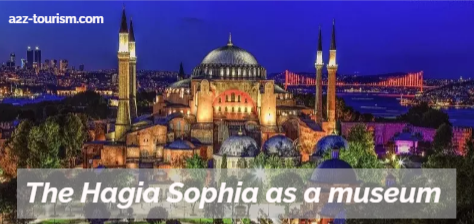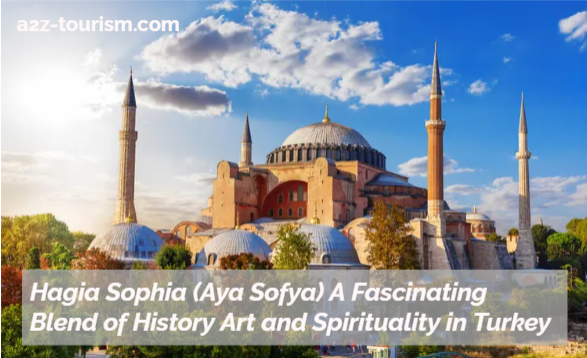Hagia Sophia (Aya Sofya) A Fascinating Blend of History Art and Spirituality in Turkey also appertained to as Aya Sofya, is a remarkable architectural masterpiece positioned in Istanbul, Turkey. It holds great significance as a symbol of the megacity’s rich history and artistic heritage. With its majesty, intricate mosaics, and literal significance, it has become one of the world’s most deified and visited milestones. Firstly constructed as an intricate edifice, Hagia Sophia latterly passed metamorphoses as a Homeric synagogue before eventually being converted into a gallery. Its witching story, emblematic value, and cultural prodigies make it a testament to mortal creativity and a cherished destination for global trippers.
literal Significance of Aya Sofya
Aya Sofya holds immense literal significance, reflecting the layers of societies that have shaped Istanbul. Firstly erected in the 6th century CE as a Christian edifice during the intricate Conglomerate, it represented the epitome of intricate armature. The structure boasted an admiration-inspiring pate, intricate mosaics, and an innovative design that inspired generations of engineers. For nearly a thousand times, Aya Sofya stood as the largest edifice in the world. II.
Transforming it into a mosque
In 1453, the intricate Conglomerate fell to the Banquettes, and Aya Sofya passed a significant metamorphosis. Sultan Mehmed II, known as Mehmed the Conqueror, converted the edifice into a synagogue, adding minarets and removing Christian iconography. The religious metamorphosis brought about architectural differences, including the addition of Islamic features like mihrabs and a minibar.

The Hagia Sophia as a museum
Following the establishment of the Republic of Turkey in 1923, Aya Sofya passed another metamorphosis. Mustafa Kemal Atatürk, the first President of Turkey, decided to convert the structure and converted it into a gallery in 1935. This decision was made to conserve both the nonfictional and cultural significance of Aya Sofya, while icing availability to people from different backgrounds.
Aya Sofya moment Hours and Tickets
As of my knowledge arrestment in September 2021, Aya Sofya operates as a gallery and is open to the public. still, please note that due to the dynamic nature of regulations and events, it’s judicious to check for the most up-to-date information regarding visiting hours and ticket prices.
Aya Sofya’s visiting hours generally vary depending on the season and day of the week. During peak sightseer seasons, similar to summer, the gallery tends to have extended hours to accommodate the affluence of callers. It’s recommended to check the sanctioned Aya Sofya website or communicate with the gallery directly for the most accurate information on opening and ending times.
Regarding tickets, callers need to buy an admission ticket to enter Aya Sofya. Ticket prices may vary for different orders of callers, similar to grown-ups, scholars, and children. also, there might be abatements or special rates for certain groups, similar to seniors or large stint groups. It’s judicious to check the sanctioned website or communicate with the gallery for the most up-to-date information on ticket prices and any applicable abatements.
Nonfictional Background
Constructed during the reign of the intricate Emperor Justinian I in the 6th century CE, Hagia Sophia stands as a testament to architectural brilliance. drafted by masterminds Anthemius of Tralles and Isidore of Miletus, the edifice was envisaged as a symbol of both Homeric power and Christian piety. The name” Hagia Sophia” translates to” Holy Wisdom” in English, emphasizing its part as a lamp of spiritual enlightenment.
Architectural Marvel
Hagia Sophia is famed for its innovative architectural design and structural achievements. The vast pate, gauging 31 measures in the periphery, represented an engineering phenomenon of its period. The objectification of pendentives to transition from a square base to an indirect pate was a revolutionary architectural fashion. Outside, the interior displays elaborate mosaics, marble columns, and exquisite Islamic penmanship, blending Christian and Islamic cultural rudiments seamlessly.
Transformation into a Mosque
In 1453, Constantinople( now Istanbul) fell to the Ottoman Empire under Sultan Mehmed the Conqueror. As a symbol of subjection, Hagia Sophia was converted into a synagogue. Islamic rudiments similar to minarets and mihrabs were added, while Christian iconography was either concealed or removed. Over the preceding centuries, the structure worked as a temple, bearing substantiation to the religious and artistic elaboration of the Ottoman Empire.
Significance as a Mosque
As a synagogue, Hagia Sophia played a vital part in the religious and artistic life of Istanbul. It was an intermediary mecca for Islamic deification, where diurnal prayers, Friday homilies, and religious gatherings took place. likewise, the pagoda performed as an educational center, casing libraries and Islamic academies within its demesne. Scholars congregated there to claw into Islamic theology, justice, and the Arabic language. The intellectual heritage of Hagia Sophia plays a vital part in the progression of Islamic education in Istanbul.
Restoration and Transformation into a Museum
In 1935, under the leadership of Mustafa Kemal Atatürk, the founder of modern Turkey, Hagia Sophia was converted into a museum. This decision aimed to preserve the historical and cultural significance of the monument while transforming it into a secular space accessible to people of all faiths and backgrounds. The museum allowed visitors to appreciate the architectural marvels, learn about the rich history, and experience the harmonious blend of Christian and Islamic influences.
The Origin of Hagia Sophia
The narrative of Hagia Sophia unfolds in the 6th century when Emperor Justinian I commissioned its construction as a monumental edifice in Constantinople, the capital of the intricate Conglomerate. drafted by Anthemius of Tralles and Isidore of Miletus, the structure was envisaged to epitomize the majesty and authority of the intricate Conglomerate. Across the periods, Hagia Sophia bore substantiation to a plethora of significant events, from Homeric coronations to the Great Schism and the Fourth Campaign.
Evolution of Hagia Sophia
In 1453, the tumble of Constantinople to the Ottoman Empire tagged an expressive turning juncture for Hagia Sophia. Converted into a synagogue, the structure passed notable differences, including the addition of minarets and the junking of Christian iconography. Over time, colorful emendations and expansions were accepted, reflecting the prevailing architectural and cultural influences of the Ottoman period. The metamorphosis saw the covering or publishing over of magnificent mosaics while introducing Islamic penmanship and ornamental rudiments.
The transition of Hagia Sophia into a museum
In 1935, a vital moment in its history passed as Hagia Sophia was repurposed as a gallery under Turkey’s secularization sweats led by Mustafa Kemal Atatürk. This transition is directed to save the headstone’s artistic and literal denotation, feeding space for individualities from distinct backgrounds to appreciate its enchantress and convention.
Architectural Marvels
The Hagia Sophia’s architectural brilliance serves as a remarkable testament to the imagination and artificer of its generators. Its massive pate, innovative construction ways, and intricate mosaics continue to allure callers. This neighborhood explores the foundational rudiments, pressing the groundbreaking blueprint of the bean, the use of pendentives, and the kingliness of the marble columns that uphold the edifice.
Artistry in Pieces: The Beauty of Mosaics
The mosaics adorning the interior of Hagia Sophia epitomize the pinnacle of intricate artistic expression. Despite enduring covering and damage throughout history, elect mosaics have been uncovered and restored, showcasing their exquisite artificer and profound religious symbolism. Notable exemplifications include the Deesis, the Abecedarian and Child, and the Comnenus mosaics.
Spiritual Significance and Rituals
Throughout centuries, Hagia Sophia has reserved abysmal spiritual denotation for votaries of both Christianity and Islam. This neighborhood delves into the sacred practices concatenated with the monument, compassing the scheduling of prayer times and the operation of the mihrab and minbar during Islamic idol idolization.
Conclusion
Hagia Sophia similarly appertained to as Aya Sofya, stands as an enduring symbol of Istanbul’s rich cultural rubric and mortal imagination. From its onsets as a Christian headstone to its posterior changeovers into a synagogue and latterly a gallery, it encapsulates the eclipse and inflow of history. moment, its emulsion of intricate intricate, Ottoman, and Islamic influences stands as a testament to the interconnectedness of societies and the holding up heritage of cultural expression. As callers cruise through its grand halls and miracle at its intricate designs, Hagia Sophia continues to elicit admiration and favor for the breadth of mortal acquirement.
FAQs
Is Ayasofya the same as Hagia Sophia?
Yes, Ayasofya is the Turkish name for Hagia Sophia, about the same literal and architectural corner.
How old is Hagia Sophia?
Hagia Sophia, or Ayasofya, is roughly 1,500 times old. Firstly constructed in the 6th century, it has experienced several emendations and variations throughout its long history.
What makes Hagia Sophia solitary?
Hagia Sophia is celebrated for its architectural and emblematic significance. It’s counted as a masterpiece of an elaborate plan, seamlessly blending rudiments of prescriptive Roman, sophisticated, and Ottoman architectural styles. Notable features include its assessing bean, intricate mosaics, and expansive intellectual cells. What sets it piecemeal is its unique combination of literal influences and its part as a symbol of artistic and religious emulsion.
Who’s Hagia Sophia named after?
Hagia Sophia derives its name from the Greek expression” Hagia Sophia,” rephrasing to” Holy Wisdom.” The full Greek name is” Megale Ekklesia tou Hagia Sophias,” meaning” Great Church of the Holy Wisdom.”
What does Ayasofya mean?
Ayasofya, the Turkish name for Hagia Sophia, is deduced from the original Greek name and translates to” Divine Wisdom” or” Holy Wisdom.”
What’s the full name of Hagia Sophia?
The full Greek name of Hagia Sophia is” Megale Ekklesia tou Hagia Sophias,” which translates to Great Church of the Holy Wisdom.

